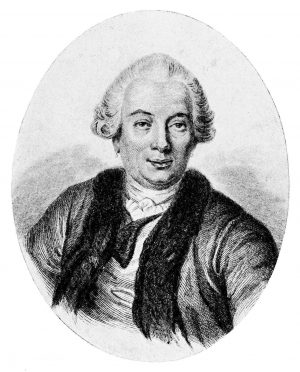Modern veterinary medicine is largely considered to have begun in 1761, when Claude Bourgelat established the first school of veterinary medicine. While this school and its coursework looked enormously different than veterinary school today, it was a real attempt to standardize veterinary practices—a solid step away from veterinary art and toward veterinary science. The need for this step was made apparent by the livestock plagues devastating Europe at the time.
Claude Bourgelat

You might be familiar with his name, but have you ever really learned about our friend, Claude? For centuries, the veterinary profession was centered around horses due to military, farming, and transportation needs, and it was through these animals that Bourgelat found his way into the realm of veterinary medicine. While he originally studied to become a lawyer, his love for horses pushed him to follow a different career path.
When we take a closer look at Bourgelat, it becomes clear he was a bit of an overachiever (that’s putting it mildly). In 1740, when he was only 28 years old, Bourgelat became director of the Lyon Academy of Horsemanship. He was considered one of the finest horse trainers of his time, and even developed a style of riding that is still used today. In his spare time (if you could tell me which couch cushions he dug this spare time out from under, I’d really appreciate it), he studied under veterinary surgeons to improve his knowledge of animal anatomy, physiology, and pathology.
In 1750, Bourgelat published a book on veterinary medicine with a mouthful of a title: “Elements of the Principles of Veterinary Art, or, New Knowledge About Medicine and Horses.” It’s in this book that we find the first hint of Bourgelat’s musings regarding the need for a veterinary school. Up until this point, veterinary medicine was practiced mostly by farriers and farmers who were either self-taught or had moved through unregulated apprenticeships. In “Elements,” Bourgelat laments the fact that those looking to practice veterinary medicine would not be able to “acquire a sufficient degree of education…since we do not have schools for teaching.”
So, he had recognized the need for a school, but there was still something standing in his way. Money. (Or a lack thereof anyway. #Relatable.) But, luckily enough for Bourgelat, King Louis XV was facing a problem of his own. Rinderpest.
Rinderpest and the Royal Veterinary School
Rinderpest's History
Rinderpest has a long and bloody history. It spread when the Huns came to Europe in the 300s and when the Mongols invaded in the 1200s. Research indicates rinderpest was associated with the fall of the Roman Empire, Charlemagne’s conquest of Europe, the French Revolution, the impoverishment of Russia, and extensive famines in Africa.
Outbreaks continued well into the 20th century, and spurred the creation of the first African veterinary school in Egypt in 1827 and the first Asian civilian veterinary school in 1872 in India. Efforts to fight rinderpest also are connected with the creation of the World Organization for Animal Health (OIE) in 1924.
In the 1950s, there was some success with vaccination programs, but they were discontinued too soon, and rinderpest had a resurgence. From 1975-1980, rinderpest devastated cattle of 18 different African countries. With renewed international eradication efforts, the last vaccine was used in 2016, and rinderpest was declared officially eradicated by OIE in 2011.
Rinderpest (AKA “cattle plague”) is a highly contagious disease that has been around since 370 CE. It affects cattle, buffalo, yak, and wild ungulates, and—with a 90 percent mortality rate—is known for wiping out entire herds; infected animals typically die a week after developing clinical signs. Throughout the centuries, rinderpest spread from country to country and continent to continent; it caused hundreds of millions of animal deaths that preceded famines in Africa, Asia, and Europe.
The outbreak in Europe in the 18th century was so terrible that Pope Clement XI’s personal physician was commissioned to help. He recommended:
- Halting cattle movement,
- Slaughtering infected animals, and
- Burying bodies of infected animals deep underground.
Still, rinderpest killed more than 200 million cattle between 1711 and 1769.
When Bourgelat’s veterinary school opened in 1761, Louis only gave it a short-term grant. But rinderpest, and the other epizootic diseases spreading through France, gave Bourgelat and his students the opportunity to prove their worth and show the value of standardized scientific training (although at the time, the training was less than a year in duration). Through the assistance veterinary medicine gave to agriculture, the devastation from rinderpest and other epizootics was stayed, and the health of livestock restored.
As a result, in 1764, Louis officially gave Bourgelat’s school the title of Royal Veterinary School, which meant it would continue to be supported by the state. With the backing of the government, Bourgelat opened a second school at Alfort, France in 1765 (this certainly cemented his status as an overachiever). Bourgelat established standards for the two schools in 1777 and continued to teach until he died in 1779 at age 67. While the school in Lyon has since moved locations, the Alfort school remains on its original site, and both schools are still in operation today.
